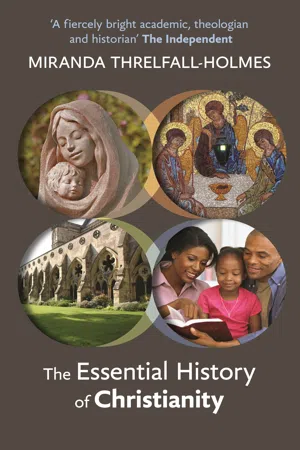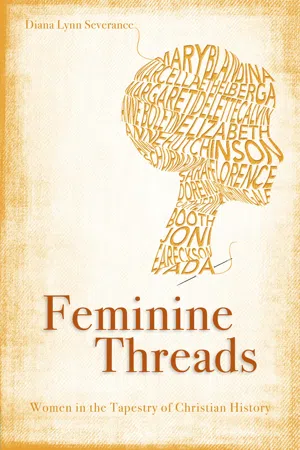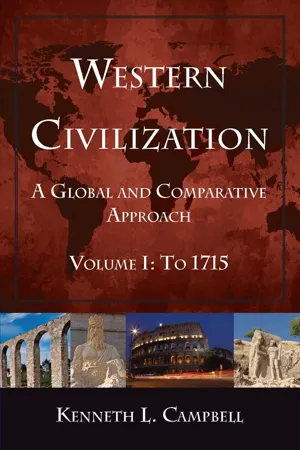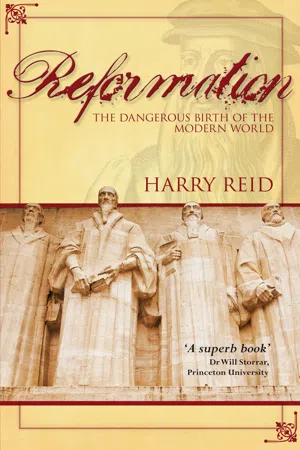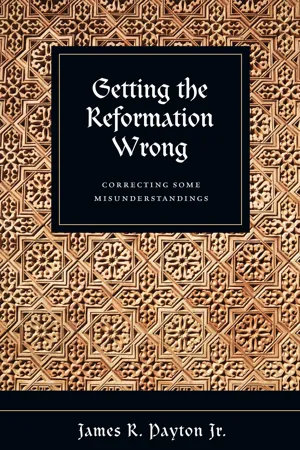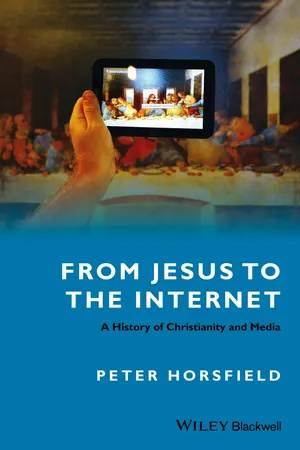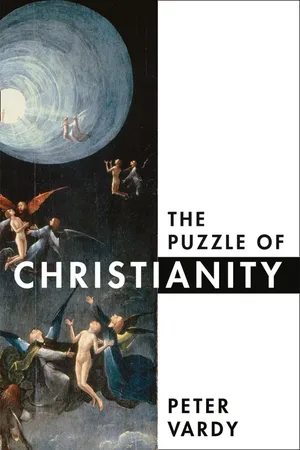History
Counter Reformation
The Counter Reformation was a period of Catholic resurgence in response to the Protestant Reformation. It aimed to address corruption within the Church, reaffirm Catholic doctrine, and regain followers lost to Protestantism. The Council of Trent, the founding of new religious orders, and the use of art and architecture to inspire faith were key elements of the Counter Reformation.
Written by Perlego with AI-assistance
Related key terms
10 Key excerpts on "Counter Reformation"
- eBook - ePub
Historical Theology
An Introduction to the History of Christian Thought
- Alister E. McGrath(Author)
- 2012(Publication Date)
- Wiley-Blackwell(Publisher)
This term is often used to refer to the revival within Roman Catholicism in the period following the opening of the Council of Trent (1545). In older scholarly works, the movement is often designated the “Counter-Reformation”: as the term suggests, the Roman Catholic church developed means of combating the Protestant Reformation, in order to limit its influence. It is, however, becoming increasingly clear that the Roman Catholic church countered the Reformation partly by reforming itself from within, in order to remove the grounds of Protestant criticism. In this sense, the movement was a reformation of the Roman Catholic church as much as it was a reaction against the Protestant Reformation.The same concerns underlying the Protestant Reformation in northern Europe were channeled into the renewal of the Catholic church, particularly in Spain and Italy. The Council of Trent, the foremost component of the Catholic Reformation, clarified Catholic teaching on a number of confusing matters, and introduced much-needed reforms in relation to the conduct of the clergy, ecclesiastical discipline, religious education, and missionary activity. The movement for reform within the church was greatly stimulated by the reformation of many of the older religious orders, and the establishment of new orders (such as the Jesuits). The more specifically theological aspects of the Catholic Reformation will be considered in relation to its teachings on Scripture and tradition, justification by faith, and the sacraments. As a result of the Catholic Reformation, many of the abuses that originally lay behind the demands for reform – whether these came from humanists or Protestants – were removed.Protestant Orthodoxy
It seems to be a general rule of history that periods of enormous creativity are followed by eras of stagnation. The Reformation is no exception. Perhaps through a desire to preserve the insights of the Reformation, the post-Reformation period witnessed the development of a strongly scholastic approach to theology. The insights of the reformers were codified and perpetuated through the development of a series of systematic presentations of Christian theology. The term “Protestant Orthodoxy” is generally used to refer to the highly systematic statements of both Lutheran and Reformed theology that emerged in the later part of the sixteenth century. - eBook - ePub
- Miranda Threlfall-Holmes(Author)
- 2012(Publication Date)
- SPCK Publishing(Publisher)
Second in this classification is the Radical Reformation. This is the name given to a whole disparate range of sects, alternative churches and experiments with alternative worshipping and lifestyles which sprang up in the ferment of debate and dissent that existed at this time. Many of these were disowned, and even occasionally persecuted, by the leaders of the Magisterial Reformation because they were perceived as going too far and being at risk of discrediting the main reforming impulses.Third, there is the Counter- or Catholic Reformation. This describes the reforming from within of the Roman Catholic Church, partially in response to the same impulses that drove the initial Reformers, and partially in an attempt to respond to the criticisms of those Reformers.BackgroundThere has been considerable academic debate over whether the movements within Roman Catholicism to reform itself should be described as the Counter-Reformation (the implication being that they were a response to Protestantism), or the Catholic Reformation (the implication being that they were an internal impulse that would have happened anyway). To some extent such a debate is irrelevant, as it is equally arguable that Luther himself initially intended to reform Catholicism from the inside, and only became a ‘Protestant’ when the Roman authorities condemned his criticisms rather than responding positively to them. It is certainly the case that Luther and the other early Reformers were part of a movement of internal criticism and renewal that had been gathering pace for some years.Renaissance literature of the period 1500–20 had lampooned and critiqued aspects of religion and the Church. Particularly notable are Erasmus’ works, such as In Praise of Folly - eBook - ePub
- Jean Berenger, C.A. Simpson(Authors)
- 2014(Publication Date)
- Routledge(Publisher)
Catholic Reformation or Counter-Reformation?On 4 December 1563, the General Council closed its third session held in the cathedral at Trent, a small episcopal city belonging to the Habsburgs. The assembly for which Charles V had incessantly called, finally, five years after his death, gave the Church a clear doctrine in the face of the diverse theological currents that issued from the Lutheran revolt. Catholicism from now onwards would strive to reconquer lost ground, gathering its faithful together in a disciplined and hierarchical society where there was no longer any place for individual states of soul and for taking an individual stance. Every Christian had to choose his or her camp since the unity of the traditional Church had been broken for once and for all. The faithful as a whole were no less nostalgic for the unity which had been lost and were convinced that their Church alone could guarantee personal salvation. There were, however, great differences in the methods employed to regain the 'errant flocks'. Some hoped to preach and convince simply by example while others employed constraints and even force, with the complicity of the state apparatus if need be.Such coercion underpinned a combative policy which can only be termed 'Counter-Reformation', even if historians today, embarrassed by the excesses of fanatacism, prefer the more eirenic name of 'Catholic Reformation'. The horrors of the past should not be glossed over and certainly both the path of gentle persuasion and violent compulsion were followed in Danubian Europe as well as a third — that of toleration. In Hungary, Poland and Transylvania the exercise of the right of patronage by the nobility eased the way for the coexistence of more than one confession within the framework of the manorial estate. - eBook - ePub
Feminine Threads
Women in the Tapestry of Christian History
- Diana Lynn Severance(Author)
- 2012(Publication Date)
- Christian Focus Publication(Publisher)
The Household of FaithDuring the fifteenth and sixteenth centuries, many recognized that the Roman Church was failing to reflect the spirit of Christ. The Roman Church’s hierarchy had accumulated tremendous wealth for itself and often administered its holdings and patronage for selfish gain. Bishops and popes seemed more involved in political intrigues than spiritual ministrations. Scholastic theologians had become sterile in their vain disputations, and the lower clergy were often illiterate, ignorant, and superstitious. While many recognized that correction was needed, they differed on the nature of the desired reforms. Protestant Reformers believed the power and tradition of the Church had supplanted the authority of the Scriptures. They sought to return the Church to the Biblical foundation of the apostolic teaching, stripped of the centuries of accumulated accretions of Church traditions. Others, however, sought to maintain the authority and tradition of the Church while bringing about a moral reformation. These latter became part of the Catholic Reformation. The Catholic Reformation, also called the Counter-Reformation, attacked the teachings of the Protestant Reformation while seeking to purify and strengthen the authority and hierarchy of the Roman Church.One important leader of the Counter-Reformation was the Spaniard Ignatius of Loyola (1491-1556), founder of the Society of Jesus, or Jesuits. The Jesuits became teachers and leaders of reform within the Roman Church. Ignatius proclaimed such loyalty to the Church that his Rule 13 of ‘Rules for Thinking with the Church’ stated, ‘I will believe that the white that I see is black if the hierarchical Church so defines it.’ Ignatius coupled this unquestioning obedience to the Church with a self-denial and mysticism which he described in his Spiritual Exercises. Ignatius’ contemporary and fellow-Spaniard, Teresa of Ávila (1515-1582), also cultivated a mystical devotion and sought reformation within the Roman Church.[1] - eBook - ePub
Western Civilization: A Global and Comparative Approach
Volume I: To 1715
- Kenneth L. Campbell(Author)
- 2014(Publication Date)
- Routledge(Publisher)
The Reformation of the sixteenth century was a religious movement that challenged the abuses, practices, and certain doctrines of the established church. It also promoted the search for a more personal faith in the context of a reformed church believed to coincide more closely with that of the first Christians. Early reformers such as Martin Luther, Huldrych Zwingli, and John Calvin concluded that the church failed to provide meaning to their personal understanding of Christianity. Many Europeans proved open to reform ideas and would reject Catholicism for a reformed faith that offered a different path to God and a different interpretation of the Christian experience. The Reformation ended up creating a complex legacy that divided Europe into rival religious camps, leading to a further intertwining of politics and religion and more than a century of religious strife and warfare.The Catholic Church experienced its own Reformation that also sparked the spiritual renewal of individuals and the bonding of communities. Some historians prefer the term Catholic Reformation instead of Counter-Reformation in recognition of the reforming movement that existed within the Catholic Church before the Protestant Reformation and that continued throughout the era. Originating with the Christian humanism of individuals such as Erasmus, a faction within the church wished to reform church abuses and to modify the church’s religious teachings in much the same direction as Luther had. The Oratories of Divine Love in sixteenth-century Italy and the work of Cardinal Francisco Ximenez de Cisneros (1436–1517) in Spain provide two examples of reform movements that did not derive their impetus from the Protestant Reformation. Cisneros attacked clerical abuses vigorously and laid the groundwork for Spain’s relative immunity from the appeal that the Protestant Reformation had elsewhere in Europe.The history of Christianity in Russia in the sixteenth and seventeenth centuries offers some compelling comparisons with the religious history of Western Europe at the time of the Reformation. Behind the divisions that occurred in both churches lay a conflict characterized by alternative approaches to spirituality and differing views about God, humanity, and the nature of religious experience. The experience of the Russian Orthodox Church suggests some important similarities in religious reform movements, as well as some striking dissimilarities that highlight the enduring differences between two distinct cultures. - eBook - ePub
Reformation
The Dangerous Birth of the Modern World
- Reid(Author)
- 2014(Publication Date)
- Saint Andrew Press(Publisher)
CHAPTER 24The Counter-ReformationLUTHER , Zwingli, Calvin, Knox, Beza and their colleagues did not reform the Church into which they were born. They were far more than mere reformers; they were revolutionaries. They created a completely new system, with new churches, based on a new theology. Their revolution was a near-disaster for the Catholic Church. For a generation, the old Church struggled; it was rocked to its foundations by the unprecedented onslaught. At first complacent, then querulous and vacillating, then afraid, seriously afraid, it just could not get the fightback under way. Partly, this was the fault of two popes – Leo X (1513–21), who simply did not understand the significance of Luther in Germany, and then Clement VII (1523–34), who was weak, timorous and tired.Then there came, almost miraculously, a succession of strong popes. These men, while very different in character, each played a key role in the outstanding movement that has been called both the Counter-Reformation and the Catholic Reformation. The first term certainly suggests a fightback; but some Catholic historians have objected to this terminology because they insist that a reform movement was already in existence before the Reformation and that it developed despite the Reformation. So, they prefer the latter term, the Catholic Reformation. But the distinguished Catholic historian Philip Hughes declared himself perfectly happy with the usage ‘Counter-Reformation’ – and, if it was good enough for him, it is most certainly good enough for me.Three things are indubitable.First, the Reformation caused colossal problems for the old Church. It lost many millions of adherents. Second, because the Catholic Church was hierarchical, much depended on the reaction and leadership of the papacy. It is significant that the fightback started in earnest with an innovatory and tenacious pope, Paul III. And third, the Counter-Reformation was, eventually, a success. From around 1540, the Catholic Church contended consistently and heroically, despite continuing internal dissent and bickering, and despite almost insuperable political difficulties. The downside was that Western Christianity was now to be split indefinitely; and there were to be some terrible wars in the name of religion. - eBook - ePub
Getting the Reformation Wrong
Correcting Some Misunderstandings
- James R. Payton Jr.(Author)
- 2010(Publication Date)
- IVP Academic(Publisher)
Reformation in RomeA s the sixteenth century dawned, the leadership of the church in Rome showed scant interest in any genuine response to the longstanding call for reformatio in capite et membris . Even a vigorous exhortation to reform offered at the Fifth Lateran Council in 1512 and the decrees enacted there stimulated no change of heart in this regard.[1] Throughout the early years of the Reformation movement, papacy and curia showed minimal interest in the issues raised in Germany and elsewhere, unless they affected the income received for the support of hierarchs, building projects and Renaissance art. Eventually, though, Rome sensed the seriousness of what had happened and launched what has come to be known as the Counter Reformation—“counter” because it rose as a response to and reaction against the Protestant Reformation.All this is true enough, but it is far from the whole story. It “gets the Reformation wrong” to limit reform endeavors within the Roman obedience to what issued from the highest levels of the hierarchy, on the one hand, or to reactions to Protestantism, on the other. This should hardly be a surprise if we consider the situation. Given a church which at the beginning of the sixteenth century encompassed virtually all of Europe outside the Ottoman Empire’s holdings, and which had so long yearned for renewal, it should occasion no surprise to discover that movements for reform from within that church had taken root and were bearing substantial fruit, both before and apart from what transpired with the Protestant Reformation. That these initiatives were not sponsored by and did not look to the papacy or curia for encouragement is hardly startling, considering how thoroughly in the two preceding centuries both cardinals and popes had squandered the trust long invested in them by Western Christendom. Nor should it be a shock to discover that these endeavors continued after the Protestant Reformation began, and that they could continue largely unaffected by that significant movement. It should also generate little surprise to learn that the Counter Reformation, for all its obvious and intended reaction to Protestantism, pursued other reform concerns as well. - eBook - ePub
From Jesus to the Internet
A History of Christianity and Media
- Peter Horsfield(Author)
- 2015(Publication Date)
- Wiley-Blackwell(Publisher)
This term has been challenged in recent decades on the basis that long before the Lutheran Reformation, there were reform movements within the Catholic Church also seeking to address some of the same issues. Scholars suggest alternative ways of describing the Catholic responses, such as the Catholic Reform 83 or, more recently, Catholic Confessionalization, a wider process of defining Catholic distinctives against alternative Christian viewpoints and the emerging secular consciousness. 84 Although there had been previous efforts at reform within the Roman Catholic Church, the Lutheran and Calvinist Reformations gave the Roman Catholic Church an added impetus to address issues that had long been recognized as undermining its effectiveness and integrity, such as moral laxity among the clergy, damaging political alliances, simony or the selling of ecclesiastical offices, the lack of clergy education, the selling of indulgences, and a growing desire among people for a more effective devotion or spirituality. The Protestant successes provided the shock for the papacy to act on these issues. Within seventeen years, the Catholic Church had lost its power in England, Denmark, Scotland, Sweden, Switzerland, and half of Germany and France, and the Netherlands and parts of Italy were unsettled. One of those actions was a calling of the Council of Trent, a council of bishops that met in twenty-five sessions over three periods between 1534 and 1563. As well as defining a number of theological issues that had been challenged by the Protestants, the council addressed some of the organizational, moral, and pastoral issues that had been the focus of the various reformers, and a new attitude of moral rectitude was instigated. Bishops and clergy were required to live within their parishes and dioceses and give greater attention to pastoral work, preaching and the public interpretation of scripture. New seminaries for the education of clergy were projected - eBook - ePub
- John Emerich Edward Dalberg, Lord Acton(Authors)
- 2016(Publication Date)
- Jazzybee Verlag(Publisher)
In connection with this repressive policy, and as its counterpart, a scheme ripened to place Rome, with its libraries, its archives, its incomparable opportunities of gathering contributory aid from every quarter of the Church, at the head of ecclesiastical literature. The Calendar was reformed. The text of the Canon Law was corrected. The Latin Vulgate was revised by Pope Sixtus himself, and every further attempt to improve it was energetically put down. Collections of councils and editions of Fathers were projected, and Baronius, of the Oratory, began the greatest history of the Church ever written, and carried it down to the eleventh folio volume.In this manner the foundations were laid of that later scholarship, that matured and completed Renaissance, by which the Catholics recovered much of the intellectual influence that had passed to other hands, and learning assisted policy in undoing the work of the reformers.The natural and inevitable centre of the movement known as the Catholic Reformation, but which, for reasons already indicated, is better called the Counter–Reformation, was Rome. It was an enterprise requiring consistency in the objects aimed at, variety in the means, combination with the Powers and avoidance of rivalry, an authority superior to national obstacles and political limitations. At first the initiative did not reside with the Papacy. Farnese, in whose pontificate the transition occurred from the religion of Erasmus to the religion of Loyola, allowed men to act for him whose spirit differed from his own. He long put off the Portuguese demand for a tribunal like the Inquisition of Castile, on the ground that it was a mere scheme of spoliation. With the elevation of Cervini in 1555, reforming or Tridentine Catholicism ascended the papal throne; but he died before his virtues or his talents could avail. Caraffa himself followed. He let the Council drop, saying that no such thing was needed, if governments did their duty. By his lack of control, he pushed things to a breach with the moderate party at home, and with the Habsburgs abroad, and the Roman people threw his statue into the Tiber, in their rejoicings when he died, and released seventy prisoners that he kept in the Inquisition. His nephews, who compromised him and had incurred disgrace in his lifetime, were put to death by his successor. They were the last papal nephews of the old type, angling for principalities and using the Papacy for their own ends. Pius IV., when he closed the Council, strove to do its work by reforms at home. Three modern saints dominated in his time, and effected a conspicuous change in the aspect of Rome. His nephew was Charles Borromeo. St. Philip Neri was the best–known and the best–loved figure in the streets of the city, and Alexandrino governed the Inquisition as an almost independent power. He succeeded, as Pius V., and then the Counter–Reformation was master. Pius was the most austere, the most ardent, the most vehement of men. He incited France to civil war, applauded the methods of Alva, deposed Elizabeth, and by incessant executions strove to maintain public decency and orthodox religion. Protestantism disappeared from Italy in his day, as it had already done in Spain. The Counter–Reformation touched high–water mark with the massacre of St. Bartholomew, a few months after his death. - eBook - ePub
- Peter Vardy(Author)
- 2016(Publication Date)
- HarperCollins Publishers(Publisher)
Engaging with this history may seem irrelevant to Christianity today, but it is essential for an understanding of the multifaceted nature of modern Christianity. Perhaps more important is a constant theme throughout this book that there are continual grassroots movements to return an institutionalised Christianity to something that more closely reflects the teaching of Jesus. Institutions and Christianity do not mix well and ordinary people recognise this. Today, the cynicism about Christianity amongst many people in the West is actually a reaction against established churches rather than Christianity itself. However, grassroots movements tend to be opposed by institutions and attempts are generally made to suppress them; this certainly happened with the Protestant Reformation.The Counter-Reformation
The Catholic Church’s reaction to the Reformation movement across Europe was understandably hostile, but intellectually there was no clear response until the Counter-Reformation. Various Catholic initiatives emerged to counter the Protestant Reformation; perhaps the most important single group was the Society of Jesus, founded in 1540 by a Spaniard, Ignatius of Loyola (1491–1556). The Jesuits were, and are, a missionary order of priests and brothers who took the usual three vows of poverty, chastity and obedience but, in addition, members of the Society took a vow of obedience to the Pope, representing their commitment to loyalty to the Catholic Church in the face of Protestants who rejected its authority. The Jesuits came to be considered the academic elite in the Catholic Church and they have a formidable record of achievements in missionary and educational work around the world. The animosity between the early Jesuits – who were concerned to stamp out what the Church saw as heresy and to maintain orthodoxy – and the Protestants was considerable. However, in the centuries since their formation, and inspired by the life of Jesus and the example of St Ignatius, tens of thousands of Jesuits have dedicated their lives to service, to education and to love of those committed to their charge. Many members of the Society represent wonderful examples of what a Christian life should be like, living simply and committed to the good of others and seeking to bring them to God. We see here, therefore, the contrast that so often occurs within all religion: the combination of terrible abuse with the heights of sanctity, love and self-sacrifice. The energy provided by the Jesuits did much to re-energise the Catholic Church and to move it onto the offensive to combat the rise of Protestantism, as well as to spread Christianity across the world. Jesuits also embraced science, and many great scientists (including a particularly large number of astronomers) have been Jesuits.
Learn about this page
Index pages curate the most relevant extracts from our library of academic textbooks. They’ve been created using an in-house natural language model (NLM), each adding context and meaning to key research topics.

